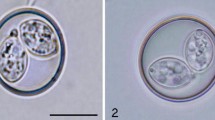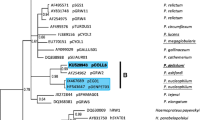Abstract
Hepatozoon mehlhori sp. nov. and its developmental stages from the tissues of the Egyptian viperEchis carinatus and the mosquitoCulex pipines are described. The erythrocytic parasites were differentiated into the small form (trophozoite) measuring 14.5±0.6×4±0.12 μm and the mature form (gametocyte) measuring 17.2±1.6×5.4±0.5μm. Merogony took place in the pulmonary endothelial cells and in the parenchyma cells of the liver and spleen of the infected vipers. Two types of meront were found. The large meronts (macromeronts) were 30.2±1.73×22.6±1.2 μm in size and yielded 16–40 (average 28) micromerozoites measuring 17.2±0.7×5±0.15 μm. The small, meronts (micromeronts) measured 18.2±0.6×13.5±0.5 μm and yielded 2–14 (average, 8) macromerozoites that were 15.1±0.12×6.2±0.8 μm in size. After syzygy in the haemocoel of the mosquito, the microgamont produced four uniflagel-late microgametes (6.4±0.3×4.5±0.5 μm in size, with a short flagellum measuring 3.2±0.1 μm); on the 3rd day post-infection (p.i.)., one of these fertilized the macrogamete, giving rise to the zygote. The oocyst developed from the zygote on the 5th day p.i. and measured 135±2.6×120±1.8 μm. About 11–60 (average, 35) sporoblasts were formed by centripetal invaginations from each oocyst on the 8th day p.i. and developed into sporocysts on the 14th day p.i. Inside each sporocyst, 5–12 (average, 8) sporozoites, each measuring 12.6±1.2×4.1±0.3 μm, developed on the 16th day p.i. According to the above-mentioned characteristics the parasite was recorded as being a new species and was namedHepatozoon mehlhorni. Experimental transmission was accomplished by i.p. inoculation of the infectious stages (sporozoites) into uninfected vipers and led to the appearance of blood stages at 4–6 weeks p.i.
Similar content being viewed by others
Abbreviations
- BLC :
-
Blood capillary
- DMS :
-
developing merozoites
- DSP :
-
developing sporoblasts
- E :
-
erythrocyte
- F :
-
flagellum
- HC :
-
host cell
- HN :
-
host nucleus
- M :
-
Meront
- MA :
-
macrogamont/macrogamete
- MG :
-
Microgamete
- MIG :
-
microgamont
- MS :
-
merozoites
- N :
-
nucleus
- NG :
-
micleus of the microgamete
- OC :
-
oocyst
- P :
-
erythrocytic parasite
- PV :
-
Parasitophorous vacuole
- SP :
-
sporoblast (s)
- SPC :
-
sporocyst (s)
- SPR :
-
sporozoite (s)
- ZY :
-
zygote (young oocyst)
References
Abdel-Ghaffar FA (1985) Light and electron microscope studies on a haemogregarine species infecting the viperCerastes vipera in Egypt. Proc Zool Soc A R Egypt 9:209–220
Allison B, Desser SS (1981) Developmental stages ofHepatozoon lygosomarum (Dore, 1919) comb. n. (Protozoa., Haemogregarinidae), a parasite of a New Zealand skink,Leiolopisma nigriplamtare. J Parasitol 67:852–858
Anderson J (1898) Zoology of Egypt. Reptilia and Batrachia, vol I. Bernard Quaritch, London
Ayala SC (1970) A haemogregarine from sandfly infecting both lizards and snakes. J Parasitol 56:387–388
Ball GH, Oda SN (1971) Sexual stages in the life history of the haemogregarineHepatozoon rarefaciens (Sambon and Seligmann, 1907). J Protozool 18:697–700
Ball GH, Chao J, Telford SR (1967) The life history ofHepatozoon rarefaciens (Sambon and Seligmann, 1907) fromDrymarchon corais (Colubridae), and its experimental transfer toConstrictor constrictor (Boidae). J Parasitol 53:897–909
Ball GH, Chao J, Telford SR (1969)Hepatozoon fusifex sp. n., a haemogregarine fromBoa constrictor producing, marked morphological changes in the infected erythrocytes. J Parasitol 55:800–813
Barber DL, Mills-Westermann JE, Storoz P (1987)Haemogregarina nototheniae, new species from the blood of Antarctic nototheniids. Syst Parasitol 10 (2):135–148
Bashtar A-R, Abdel-Ghaffar FA (1987) Light microscope study on the life cycle ofHaemogregarina najae infecting the snakeNaja nigricollis nigricollis (Elapidae, Proteroglypha, Squamata) from Egypt. Proc Zool Soc A R Egypt 14:33–44
Bashtar A-R, Boulos R, Mehlhorn H (1984)Hepatozoon aegypti nov. sp.: I. Life cycle. Z Parasitenkd 70:29–41
Bashtar A-R, Abdel-Ghaffar FA, Shazly MA (1987) Developmental stages ofHepatozoon gracilis (Wenyon 1909) comb. nov., a parasite of the Egyptian skink,Mabuya quinquetaeniata. Par asitol Res 73:507–514
Beyer TV (1977) Electron microscope study ofKaryolysus sp. (Sporozoa: Adeleida; Haemogregarinidae) and of changes induced in the infected host cell. Protistologica XIII:57–66
Beyer TV (1982) Ultrastructural interrelation between lizard erythrocytes and haemogregarines (Karyolysus, Haemogregarinidae). Proceedings of the 5th International Congress on Parasitology (Toronto, 23–26 August 1982) p 98
Beyer TV, Scholtyseck E, Entzeroth R (1983) Fine structure of the merozoite of a haemogregarine from the testis of a lizard. Z Parasitenkd 69:439–445
Chatton E, Roubaud E (1913) Sporogonie d'une hemogregarine chez une tsetse (Glossina palpalis R. Desv.). Bull Soc Pathol Exot 6:226–233
Conceiçao Silva FM, Abranches P, Silva-Pereira MCD, Janz JG (1988) Hepatozoonosis in foxes from Portugal. J Wildl Dis 24(2):344–347
Davidson WR, Calpin JP (1976)Hepatozoon griseisciuri infection in grey squirrels of the Southeastern U.S. J Wildl Dis 12:72–76
Elwasila M (1989)Haemogregarina sp. (Apicomplexa: Adeleorina) from the geckoTarentola annularis in the Sudan: fine structure and life-cycle trials. Parasitol Res 75(6):444–448
Fantham HB, Porter A, Richardson LR (1942) Some haematozoa observed in vertebrates in eastern Canada. Parasitology 34:199–226
Furman DP (1966)Hepatozoon balfouri (Laveran, 1905): sporogonic cycle, pathogenesis, and transmission by mites to jerboa hosts. J Parasitol 52:373–382
Göbel E, Krampitz HE (1982) Histologische Untersuchungen zur Gamogonie und Sporogonie vonHepatozoon erhardovae in experimentell infizierten Rattenflöhen (Xenopsylla cheopsis). Z Parasitenkd 67:261–271
Hammond DM (1973) Life cycles and development of Coccidia. In: Hammond DM (ed) The Coccidia. University Park Press, Baltimore, pp 45–79
Hawking F, Perry W.L., Thurston JP (1948) Tissue forms ofPlasmodium cynomolgi. Trans R Soc Trop Med Hyg 42:10–14
Hoare CA (1932) On protozoal blood parasites collected in Uganda with an account of the life cycle of the crocodile haemogregarines Parasitology 24:210–224
Khan RA, Forrester DJ, Goodwin TM, Ross CA (1980) A haemogregarine from the American alligatorAlligator mississippiensis. J Parasitol 66:324–328
Killick-Kendrick R (1984) Parasitic Protozoa of the blood of rodents: VI. Two new haemogregarines of the pygmy flying squirrelIdiurus macrotis (Rodentia: Theridomyomorpha: Anomaluridae) in West Africa. J Protozool 31:532–535
Kirmse P (1979) The ultrastructure ofHaemogregarina sachai (Coccidia: Adeleidea) from the farmed marine flat fishScophthalmus maximus L. Z Parasitenkd 58:201–210
Krampitz HE (1964) Über das Vorkommen und Verhalten von Haemococcidien der GattungHepatozoon Miller, 1908 (Protozoa, Adeleidca) in mittel- und südeuropäischen Säugern. Acta Trop (Basel) XXI:114–154
Landau I, Michel JC, Chabaud AG, Brygoo ER (1972) The lifehistory ofHepatozoor domerguei, comments on the fundamental characteristics of a coccidian life-cycle. Z Parasitenkd 38:250–270
Levine ND (1982) Some corrections in Haemogregarine (Apicomplexa: Protozoa) nomenclature. J Protozool 29:601–603
Lewis JE, Wagner ED (1964)Hepatozoon sauromali sp. n., a haemogregarine from the Chuckwalla (Sauromalus spp.) with notes on the life history. J Parasitol 50:11–14
Mackerras JM (1962) The life history of aHepatozoon, (Sporozoa: Adeleidea) of varanid lizards in Australia. Aust J Zool 10:35–44
Mehlhorn H (1988) Parasitology in focus: Facts and trends. Springer, Berlin Heidelberg New York
Michel JC (1973)Hepatozoon mauritanicum (Et. et Ed. Sergent, 1904) n. comb., parasite deTestudo graeca: redescription de la sporogome chezHyalomma aegyptium et de la schizogonie tissularie d'apres le matérial d'E. Brump. Ann Parasitol Hum Comp 48:11–21
Nadler SA, Miller JH (1984) A redescription ofHepatozoon mocassini (Laveran, 1902) n. comb. fromAgkistrodon piscivorus leu costoma Troost, 1836. J Protozool 31:321–324
Paterson WB, Desser SS (1976) Observations onHaemogregarina balli sp. n. from the common snapping turtle,Chelydra serpentina. J Protozool 23:294–301
Robin LA (1936) Cycle evolutif d'unHepatozoon deGrecko verticillatus. Ann Inst Pasteur 56:376–394
Shanavas KR, Ramachandran P (1990) Life-history ofHepatozoon octosporei sp. n., a new haemogregarine from the skink,Mabuya carinata (Schneider), with notes on the in vitro excystment of its oocysts. Arch Protistenkd 138:127–137
Sinha CK (1986)Hepatozoon mucosus sp. n. from Indian rat snakes,Ptyas mucosus (Linnaeus). Acta Protozool 25:471–476
Author information
Authors and Affiliations
Rights and permissions
About this article
Cite this article
Bashtar, A.R., Abdel-Ghaffar, F.A. & Shazly, M.A. Life cycle ofHepatozoon mehlhorni. sp. nov. in the viperEchis carinatus and the mosquitoCulex pipiens . Parasitol Res 77, 402–410 (1991). https://doi.org/10.1007/BF00931635
Accepted:
Issue Date:
DOI: https://doi.org/10.1007/BF00931635




